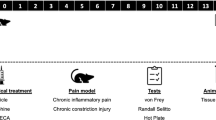Abstract
In electrophysiological and behavioral experiments on rats we studied the effects of pefloxacin, a member of fluoroquinolone family, on the nociceptive system. Intraperitoneal injection of pefloxacin (80 mg/kg) decreased the thresholds of nociceptive response to noxious stimulation in the hot-plate test. In addition, it decreased the threshold of the late component of nociceptive flexor reflex. Intrathecal application of pefloxacin in a dose of 20 μg provoked allodynia, while the higher dose of 400 μg induced behavioral pattern characteristic of central pain syndrome. It was hypothesized that pain induced by pefloxacin results from disturbances in GABAergic inhibition in the central subdivisions of the nociceptive system.
Similar content being viewed by others
REFERENCES
G. N. Kryzhanovskii, Zh. Nevropatol. Psikhiatr., 99, No. 12, 4-7 (1999).
G. N. Kryzhanovskii, V. K. Reshetnyak, V. A. Zinkevich, et al., Byull. Eksp. Biol. Med., 122, No. 9, 258-261 (1996).
M. L. Kukushkin and S. I. Igon'kina, Ibid., 135, No. 6, 647-651 (2003).
E. R. Padeiskaya and V. P. Yakovlev, Antimicrobial Agents of Fluoroquinolone Family in Clinical Practice [in Russian], Moscow (1998).
W. Christ and B. Esch, Inf. Dis. Clin. Pract., 3, 168-176 (1994).
J. S. Cohen, Ann. Pharmacother., 35, 1540-1547 (2001).
J. M. Domagala, J. Antimicrob. Chemother., 33, 685-708 (1994).
H. L. Du Pont, Clin. Drug Invest., 11, Suppl. 2, 25-29 (1996).
H. Fukuda and Y. Kawamura, Jpn. J. Antibiot., 55, No. 3, 270-280 (2002).
D. C. Hooper and J. S. Wolfson, in: Quinolone Antimicrobial Agents, Eds. D. C. Hooper et al., Washington (1993), pp. 482-512.
D. Le Bars, M. Gozariu, and S. W. Cadden, Pharmacol. Rev., 53, 597-652 (2001).
P. S. Lietman, Drugs, 49, Suppl. 2, 159-163 (1995).
N. Rosentiel and D. Adam, DrugsIbid., 47, 872-901 (1994).
A. Tripathi, S. I. Chen, and S. O'Sullivan, Arch. Ophtalmol., 120, 665-666 (2002).
T. L. Yaksh, Pain., 37, 111-123 (1989).
Author information
Authors and Affiliations
Rights and permissions
About this article
Cite this article
Kukushkin, M.L., Igonkina, S.I. & Guskova, T.A. Mechanisms of Pefloxacin-Induced Pain. Bulletin of Experimental Biology and Medicine 137, 336–338 (2004). https://doi.org/10.1023/B:BEBM.0000035122.45148.93
Issue Date:
DOI: https://doi.org/10.1023/B:BEBM.0000035122.45148.93




